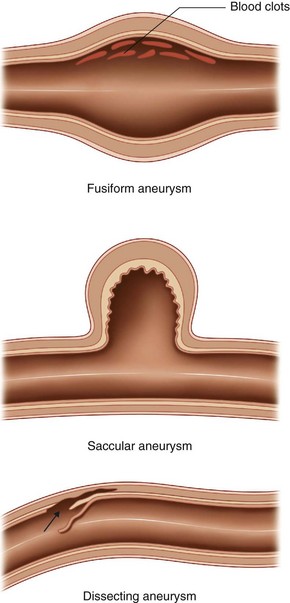5 Common cardiovascular diseases
5.1 Atheroma
5.1.2 Etiology
• higher incidence in men than in women until menopause
• food rich in refined carbohydrates, cholesterol, and saturated fatty acids
Most of the time, a combination of factors underlies the formation of plaque.
5.3 Arterial aneurysm
5.3.2 Etiology
Although the pathogenesis of an aneurysm is unclear, there are several predisposing factors:
5.3.3 Forms
Types of aneurysm (Fig. 5.1) include:
• Fusiform distensions occur in the entire circumference of the vessel wall, affecting mainly the aorta and sometimes the iliac arteries. These aneurysms present with atheromatous lesions.
• Saccular aneurysm is a localized dilation of a vessel wall in which a small area, rather than the entire circumference, is distended, forming a sac-like swelling. These aneurysms can be due to defective collagen, atheromatous lesions, or congenital weakness.
• Dissecting aneurysm is a localized dilation, most commonly in the arch of the aorta. It is characterized by an infiltration of blood between the outer and middle layers of the vessel wall. It begins as an endothelial tear and extends little by little to become a longitudinal dissection along the artery.
• Microaneurysms occur in small arteries and arterioles of the brain. They are linked to hypertension. Transitory ischemic accidents are often the result of a thrombus or hemorrhage of these aneurysms.
Stay updated, free articles. Join our Telegram channel

Full access? Get Clinical Tree









